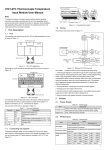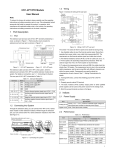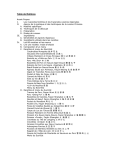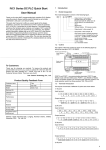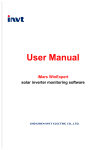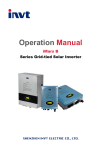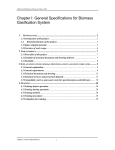Download IVC1-2AD Analog Input Module User Manual
Transcript
IVC1-2AD Analog Input Module 1.2 Connecting Into System Through the extension cable, you can connect IVC1-2AD to IVC1 series basic module or other extension modules. While through the extension port, you can connect other IVC1 series extension modules to IVC1-2AD. See Figure 1-3. User Manual Note: Removing extension port cover before connection To reduce the chance of accident, please carefully read the operating instructions and safety precautions prior to use. Only adequately trained personnel shall install or operate this product. In operation, strict compliance with applicable safety rules in the industry, the operating instructions and safety precautions in this book is required. 1 Port Description Extension module Extension cable Main module 1.1 Port Figure 1-3 Connecting into system The extension port and user port of IVC1-2AD are both protected by a cover, as shown in Figure 1-1. Extension port cover 1.3 Wiring 24V RUN POWER Figure 1-4 shows the wiring of the user port. Voltage input V2+ I2+ VI2FG IVC1-2AD ② ① AGND Current input ② User port cover ① ⑥ Figure 1-1 IVC1-2AD appearance ④ PGND Extension cable DC24V±10% 60mA AGND ③ V1+ I1+ VI1FG 390K 130K AGND 130K 390K 390K 130K AGND 130K 390K +5V DC/DC converter 24V- CH1 250 24V+ ⑤ CH2 250 AGND -5V ⑦ Removing the covers reveals the extension port and user port, as shown in Figure 1-2. IVC1-2AD EC -2AD 10 Extension port 1 4 6 3 24V24V24V+ RUN 13 2 User port Figure 1-4 Wiring of IVC1-2AD user port 14 24V POWER 2 8 5 7 FG V1+ 10 9 12 11 14 13 16 15 18 17 The circled 1~7 stands for the seven points to be observed during wiring. 20 19 1. It is recommended to use shielded twisted pair for the analog input. Route them separate from power cables and any cable that may generate EMI. 2. If input signal fluctuates or there is strong EMI in external wiring, it is advisable to use a smoothing capacitor (0.1µF~0.47µF/25V). VI1FG VI2VI1VI2 I1+ V2+ I2+ IVC1-2AD 3. If a channel is used for current input, short its voltage input terminal and current input terminal. 4. If strong EMI exists, connect the FG terminal and PG terminal. 5. Properly ground the module’s PG terminal. Extension cable Figure 1-2 IVC1-2AD ports The extension cable connects IVC1-2AD to the system, while the extension port connects IVC1-2AD to another extension module of the system. For details on connection, see 1.2 Connecting Into System. The user port of IVC1-2AD is described in Table 1-1. Terminal 1 2 Table 1-1 User port description Name Description 24V+ Analog power supply 24V+ 24VAnalog power supply 24V- 4 GND 5, 9 6, 10 7, 11 8, 12 V1+, V2+ FG I1+, I2+ VI1-, VI2- 3, 13 ~ 20 · Voltage input of CH1 ~ CH2 Shielding ground Current input of CH1 ~ CH2 Common GND of CH1 ~ CH2 6. The basic module’s 24Vdc auxiliary power or other qualified external power supply can be used as the power source of the module’s analog circuit. 7. Do not use the NC terminal of the user port. 2 Indices 2.1 Power Supply Table 2-1 Power supply Description 24Vdc (-15%~20%), maximum allowable ripple voltage 5%, Analog circuit 50mA (from basic module or external power supply) Digital circuit 5Vdc, 70mA (from basic module) Item NC Note: an input channel cannot receive both voltage signals and current signals at the same time. If you intend to use a channel for current signal measurement, please short its voltage signal input terminal and current signal input terminal. 1 Bit status of BFM#300 2.2 Performance Item Conversion speed Voltage Analog input range Current Table 2-2 Performance Specifications 15ms/channel (normal speed), 6ms/channel (high speed) Two channels can be -10Vdc ~ +10Vdc, input impedance: 1MΩ used at the same time, input range can be -20mA ~ +20mA, input selected by setting BFM impedance: 250Ω (see Table 2-5) Default: –2000 ~ +2000 Setting range: -10000 ~ +10000 Voltage input Depending on the input range (see Table 2-5) Resolution Current input 10µA Accuracy ±1% of full range Between analog circuit and digital circuit: photocoupler. Between analog circuit and input Isolation 24Vdc power: DC/DC converter. Between analog channels: none Digital output IVC1-2AD exchanges data with the basic module through Buffer Memory (BFM). After IVC1-2AD is set through the host software, the basic module will write data into IVC1-2AD BFM to set the state of IVC1-2AD, and display the data from IVC1-2AD on the host software interface. See figures 4-2 ~ 4-6. Table 2-3 describes the contents of the BFM of IVC1-2AD. #700 #701 #900 #901 #902 #903 #904 #905 #906 #907 #2000 #4094 #4095 b3: hardware fault b10: digital range error b11: average sampling times setting error OFF (0) AD converter or other hardware faulty Digital output after AD conversion less than –2048 or greater than +2047 Setting outside normal range (in this case, the previous valid setting will be restored) Hardware normal Digital output value normal Setting within normal range: 1~4096 4. BFM#600: input mode selection, used to set the input modes of CH1 ~ CH2. See Figure 2-1 for their correspondence. # 600 0 x ×4 ×3 ×2 ×1 Input mode for CH1 Input mode for CH2 Reserved Reserved Figure 2-1 Mode setting element vs. channel Table 2-5 shows the status information of BFM#600. 2.3 Buffer Memory BFM #100 #101 #200 #201 #300 #600 ON (1) Table 2-5 BFM#600 information table Value of X Status information 0 -10V~10V voltage input mode 1 –5V~5V voltage input or -20mA~20mA current input mode 3 Channel closed For example, if #600 is written as ‘0x0001’, the setting will be like this: Table 2-3 BFM Contents Contents Default Average value of CH1 Average value of CH2 Current value of CH1 Current value of CH2 Error status 0 Input mode selection 0x0000 Average sampling times of 8 CH1 Average sampling times of 8 CH2 CH1-D0 0 (input mode 0) CH1-A0 0 (input mode 0) CH1-D1 2000 (input mode 0) CH1-A1 10000 (input mode 0) CH2-D0 0 (input mode 0) CH2-A0 0 (input mode 0) CH2-D1 2000 (input mode 0) CH2-A1 10000 (input mode 0) AD conversion speed 0 (15ms/CH) switchover Module software version 0x1000 Module ID 0x1021 Property R R R R R RW RW RW RW R RW R RW R RW R RW R R 1) Input range of CH1: -5V ~ 5V or -20mA ~ 20mA (note the wiring difference in voltage and current, see 1.3 wiring); 2) Input range of CH2: -10V ~ 10V. 5. BFM#700~BFM#701: average sampling times setting; setting range: 1~4096. Default: 8 (normal speed); choose 1 if high speed is needed. 6. BFM#900 ~ BFM#907: channel characteristics settings, which are set using two-point method. D0 and D1 represent the channel’s digital outputs, while A0 and A1, in mV unit, represent the channel’s actual inputs. Each channel occupies 4 words. To simplify the setting operation without affecting functions, A0 and A1 are respectively fixed to 0 and the maximum analog value in the present mode. After changing the channel mode (BFM #600), A0 and A1 will change automatically according to the mode. Users cannot change them. Note: If the channel input is current signal (-20mA~20mA), the channel mode should be set to 1. As the channel’s internal measurement is based on voltage signal, current signals should be converted into voltage signals (-5V ~ 5V) by the 250Ω resistor at the current input terminal of the channel. A1 in the channel’s characteristics setting is still in mV unit, i.e., 5000mV (20mA×250Ω =5000mV). 7. BFM#2000: AD conversion speed setting. 0: 15ms/channel (normal speed); 1: 6ms/channel (high speed). Setting BFM#2000 will restore BFM#700~#701 to the default values, which should be noted in programming. If necessary, you can re-set BFM#700~#701 after you change the conversion speed. 1. CH1 stands for channel 1; CH2, channel 2. 8. BFM#4094: module software version, displayed automatically as Module Version in IVC1-2AD Configuration dialogue box of the host software, as shown in Figure 4-2. 2. Property explanation: R means read only. An R element cannot be written. RW means read and write. Reading from a non-existent element will get 0. 8. BFM#4095 is module ID. ID of IVC1-2AD is 0x1021. The user program in PLC can use this ID to identify the module before transceiving data. Explanation: 3. Status information of BFM#300 is shown in Table 2-4. 3 Table 2-4 Status information of BFM#300 Bit status of BFM#300 ON (1) OFF (0) b1 or b2 is ON, AD conversion of No error all channels stopped b1: channel Channel Channel characteristics setting characteristics setting characteristics error in BFM error setting normal b2: power supply Power supply 24Vdc power supply failed failure normal b0: error Setting Characteristics The input channel characteristic of IVC1-2AD is the linear relationship between the channel’s analog input A and digital output D. It can be set by the user. Each channel can be considered as the model shown in Figure 3-1. As it is of linear characteristics, the channel characteristics can be defined by just two points: P0 (A0, D0) and P1 (A1, D1), where D0 is the channel’s digital output corresponding to analog input A0, and D1 is the channel’s digital output corresponding to analog input A1. 2 5 Figure 4-4 Changing CH1 characteristic Notice 1. The warranty range is confined to the PLC only. 2. Warranty period is 18 months, within which period INVT Auto-control Technology Co. Ltd. conducts free maintenance and repairing to the PLC that has any fault or damage under the normal operation conditions. 3. The start time of warranty period is the delivery date of the product, of which the product SN is the sole basis of judgment. PLC without a product SN shall be regarded as out of warranty. 4. Even within 18 months, maintenance will also be charged in the following situations: Damages incurred to the PLC due to mis-operations, which are not in compliance with the User Manual; Damages incurred to the PLC due to fire, flood, abnormal voltage, etc; Damages incurred to the PLC due to the improper use of PLC functions. 5. The service fee will be charged according to the actual costs. If there is any contract, the contract prevails. 6. Please keep this paper and show this paper to the maintenance unit when the product needs to be repaired. 7. If you have any question, please contact the distributor or our company directly. Shenzhen INVT Auto-control Technology Co., Ltd. Address: Gaofa Industry Park, Longjing ,Nanshan District 518055, Shenzhen China Homepage: www.invt-control.com Figure 4-5 Changing CH2 characteristic Operation Inspection February 15, 2012 Revision date V1.0 Version All rights reserved. The contents in this document are subject to change without notice. 5.1 Routine Inspection 1. Check that the wiring of analog input meets the requirements (see 1.3 wiring). 2. Check that the extension cable of IVC1-2AD is properly inserted in the extension port. 3. Check that the 5V and 24V power supplies are not overloaded. Note: the digital circuit of IVC1-2AD is powered by the basic module through the extension cable. 4. Check the application and make sure the operation method and parameter range are correct. 5. Set the IVC1 main module to RUN state. 5.2 Inspection Upon Fault In case of abnormality, check the following items: ● The status of the POWER indicator ON: the extension cable is properly connected; OFF: check the extension cable connection and the basic module. ● The wiring of analog input ● The status of the 24V indicator ON: 24Vdc power supply normal; OFF: 24Vdc power supply possibly faulty, or IVC1-2AD faulty. ● the status of the RUN indicator Flash quickly: IVC1-2AD in normal operation; Flash slowly or OFF: Check the Error Status in IVC1-2AD Configuration dialogue box through the host software. 4 A Analog input Channel D P1 D1 D0 D P0 A0 Digital output A( mV ) A1 Channel model Channel characteristics setting Figure 3-1 Channel characteristics of IVC1-2AD To simplify the operation process without affecting functions, A0 and A1 are respectively fixed to 0 and the maximum analog value in the present mode. That is to say, in Figure 3-1, A0 is 0 and A1 is the maximum analog input in the present mode. A0 and A1 will change according to the mode when BFM#600 is changed. Users cannot change their values. If you just set the channel mode (BFM#600) without changing the D0 and D1 of the corresponding channel, the channel characteristics vs. mode should be as shown in Figure 3-2. The A in Figure 3-2 is default. D 2000 Figure 4-1 Set the module address D 2000 A( mV ) 0 -10000 10000 A(mV) - 5000 - 2000 0 5000 - 2000 A. mode 0 (factory settings) Figure 3-2 B. mode 1 Characteristics vs. mode without changing D0 and D1 You can change the channel characteristics by changing D0 and D1. The setting range of D0 and D1 is -10000 ~ 10000. If the setting is outside this range, IVC1-2AD will not accept it, but maintain the original valid setting. Figure 3-3 provides for your reference an example of changing channel characteristics. Figure 4-2 CH1 setting interface D 2000 D 10000 P1 P1 A ( mV) 0 - 5000 A( mV ) 0 P0 -10000 - 500 1000 P0 5000 10000 - 10000 - 3000 A B Mode 0, D0 = 0, D1 = 10,000 Mode 1, D0 = -500, D1 = 2000 Analog input 10V outputs 10,000 Analog input 5V (or 20mA) outputs 2000 Analog input 0V outputs 0 Analog input 1V (or 4mA) outputs 0 Analog input -5V (or -20mA) outputs Analog input -10V outputs -10,000 -3000 Changing input channel characteristics Figure 3-3 4 Application Example Figure 4-3 CH2 setting interface 4.2 Changing Characteristics 4.1 Basic Application Example: IVC1-2AD module address is 1 (for the addressing of extension modules, see IVC1 Series PLC User Manual). Use CH1 for voltage input (-10V~10V), use CH2 for current input (-20~20mA), set the average sampling times to 4, and use data registers D1 and D2 to receive the average value, as shown in the following figures. Example: The IVC1-2AD module address is 3 (for the addressing of extension modules, see IVC Series PLC User Manual). Set the average sampling times to 4, set characteristics A and B in Figure 3-3 respectively for CH1 and CH2, and use data registers D1 and D2 to receive the average value, as shown in the following figures. 3




